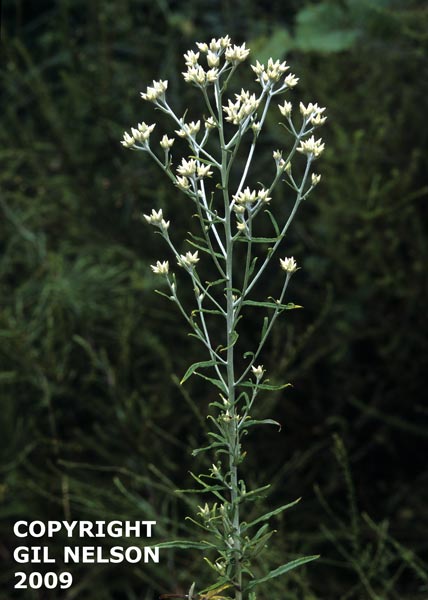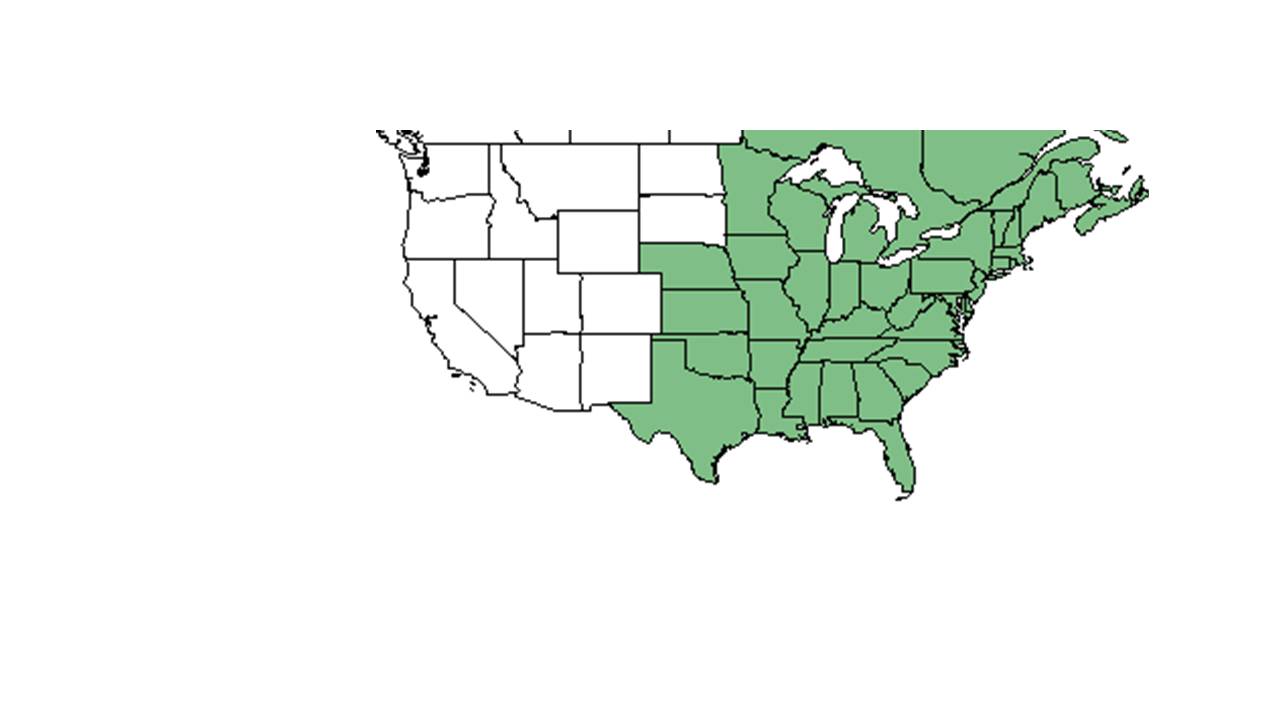Difference between revisions of "Pseudognaphalium obtusifolium"
(→Ecology) |
(→Taxonomic notes) |
||
| (2 intermediate revisions by 2 users not shown) | |||
| Line 18: | Line 18: | ||
}} | }} | ||
| − | Common names: | + | Common names: rabbit tobacco or sweet everlasting(Nelson 2005), eastern rabbit-tobacco, fragrant rabbit-tobacco<ref name=weakley>Weakley, A.S. 2020. Flora of the Southeastern United States. Edition of 20 October 2020. University of North Carolina at Chapel Hill, Chapel Hill, North Carolina.</ref> |
==Taxonomic notes== | ==Taxonomic notes== | ||
| − | Synonyms: ''Gnaphalium obtusifolium'' Linnaeus; ''Gnaphalium obtusifolium'' | + | Synonyms: ''Gnaphalium obtusifolium'' Linnaeus; ''Gnaphalium obtusifolium'' var. ''obtusifolium''<ref name=weakley/> |
| − | + | ||
| + | Varieties: ''Gnaphalium obtusifolium'' var. ''obtusifolium''; ''Gnaphalium obtusifolium'' Linnaeus var. ''praecox'' Fernald<ref name=weakley/> | ||
| + | |||
==Description== | ==Description== | ||
<!-- Basic life history facts such as annual/perrenial, monoecious/dioecious, root morphology, seed type, etc. --> | <!-- Basic life history facts such as annual/perrenial, monoecious/dioecious, root morphology, seed type, etc. --> | ||
| Line 43: | Line 45: | ||
Populations of ''Pseudognaphalium obtusifolium'' have been known to persist through repeated annual burning.<ref>Platt, W.J., R. Carter, G. Nelson, W. Baker, S. Hermann, J. Kane, L. Anderson, M. Smith, K. Robertson. 2021. Unpublished species list of Wade Tract old-growth longleaf pine savanna, Thomasville, Georgia.</ref> | Populations of ''Pseudognaphalium obtusifolium'' have been known to persist through repeated annual burning.<ref>Platt, W.J., R. Carter, G. Nelson, W. Baker, S. Hermann, J. Kane, L. Anderson, M. Smith, K. Robertson. 2021. Unpublished species list of Wade Tract old-growth longleaf pine savanna, Thomasville, Georgia.</ref> | ||
| − | ===Pollination and | + | <!--===Pollination===--> |
| + | ===Herbivory and toxicology===<!--Common herbivores, granivory, insect hosting, poisonous chemicals, allelopathy, etc--> | ||
''Pseudognaphalium obtusifolium'' has been observed at the Archbold Biological Station to host wasps such as ''Cerceris blakei'' (family Sphecidae).<ref name=dey> Deyrup, M.A. and N.D. 2015. Database of observations of Hymenoptera visitations to flowers of plants on Archbold Biological Station, Florida, USA.</ref> | ''Pseudognaphalium obtusifolium'' has been observed at the Archbold Biological Station to host wasps such as ''Cerceris blakei'' (family Sphecidae).<ref name=dey> Deyrup, M.A. and N.D. 2015. Database of observations of Hymenoptera visitations to flowers of plants on Archbold Biological Station, Florida, USA.</ref> | ||
<!--===Diseases and parasites===--> | <!--===Diseases and parasites===--> | ||
Latest revision as of 15:43, 14 July 2023
| Pseudognaphalium obtusifolium | |
|---|---|

| |
| Photo taken by Gil Nelson | |
| Scientific classification | |
| Kingdom: | Plantae |
| Division: | Magnoliophyta – Flowering plants |
| Class: | Magnoliopsida – Dicotyledons |
| Order: | Asterales |
| Family: | Asteraceae ⁄ Compositae |
| Genus: | Pseudognaphalium |
| Species: | P. obtusifolium |
| Binomial name | |
| Pseudognaphalium obtusifolium (L.) Hilliard & B.L. Burtt | |

| |
| Natural range of Pseudognaphalium obtusifolium from USDA NRCS Plants Database. | |
Common names: rabbit tobacco or sweet everlasting(Nelson 2005), eastern rabbit-tobacco, fragrant rabbit-tobacco[1]
Contents
Taxonomic notes
Synonyms: Gnaphalium obtusifolium Linnaeus; Gnaphalium obtusifolium var. obtusifolium[1]
Varieties: Gnaphalium obtusifolium var. obtusifolium; Gnaphalium obtusifolium Linnaeus var. praecox Fernald[1]
Description
A description of Pseudognaphalium obtusifolium is provided in The Flora of North America.
Distribution
It is found in medium-sized gaps in a study investigating the interacting effects of overstory removal and ungulate herbivory in a hemlock hardwood forest in Alberta, Michigan.[2]
Ecology
Habitat
In the Coastal Plain in Florida and Georgia, P. obtusifolium can be found in mesic hardwoods, turkey oak scrubs, longleaf pine/scrub oak stands, pine flatwoods, bordering cattail marshes, sand ridges, cypress pond margins, annually burned pine savannas, and annually burned mature longleaf pine-wiregrass communities.[3][4] It can also be found in roadside ditches, and open fields. Soil types include loamy sand, peat soils, sandy loam, and clay soil.[3] Associated species include slash pine, loblolly bay, longleaf pine, wiregrass, Liatris, Panicum, Leptoloma cognata, Polygonella, and Amphicarpum.[3] It has been observed that five to eight years after thinning a longleaf pine stand there was an increase in the frequency of P. obtusifolium.[5]
Phenology
P. obtusifolium has been observed to flower in March and August through October.[3][6]
Seed dispersal
This species is thought to be dispersed by wind.[7]
Fire ecology
Populations of Pseudognaphalium obtusifolium have been known to persist through repeated annual burning.[8]
Herbivory and toxicology
Pseudognaphalium obtusifolium has been observed at the Archbold Biological Station to host wasps such as Cerceris blakei (family Sphecidae).[9]
Conservation, cultivation, and restoration
Cultural use
Photo Gallery
References and notes
- ↑ 1.0 1.1 1.2 Weakley, A.S. 2020. Flora of the Southeastern United States. Edition of 20 October 2020. University of North Carolina at Chapel Hill, Chapel Hill, North Carolina.
- ↑ Holmes, S. A. and C. R. Webster 2011. Herbivore-induced expansion of generalist species as a driver of homogenization in post-disturbance plant communities. Plant Ecology 212: 753-768.
- ↑ 3.0 3.1 3.2 3.3 Florida State University Robert K. Godfrey Herbarium database. URL: http://herbarium.bio.fsu.edu. Last accessed: July 2015. Collectors: Loran C. Anderson, David Hall, Gary Schultz, Cecil R Slaughter, A. F. Clewell, R.K. Godfrey, R. E. Perdue, Jr., Rev. Robert Brinker, James P. Gillespie, C. Jackson, Paul L. Redfearn, Jr., Richard S. Mitchell, Gary R. Knight, H. E. Grelen, H. Larry Stripling, D. B. Ward, E. S. Ford, R. Komarek, William D. Reese, Dianne Hall, MacClendons, G. Wilder. States and Counties: Florida: Bay, Calhoun, Citrus, Clay, Dixie, Escambia, Franklin, Gadsden, Gulf, Hamilton, Jackson, Lafayette, Leon, Liberty, Nassau, Putnam, Volusia, Wakulla. Georgia: Grady, Thomas. Compiled by Tall Timbers Research Station and Land Conservancy.
- ↑ Nelson, Gil. East Gulf Coastal Plain Wildflowers. A Field Guide to the Wildflowers of the East Gulf Coastal Plain, including Southwest Georgia, Northwest Florida, Southern Alabama, Southern Mississippi, and Parts of Southeastern Louisiana. Guilford, CT: Falcon, 2005. 115. Print.
- ↑ Harrington, T. B. 2011. Overstory and understory relationships in longleaf pine plantations 14 years after thinning and woody control. Canadian Journal of Forest Research 41: 2301-2314.
- ↑ Nelson, G. PanFlora: Plant data for the eastern United States with emphasis on the Southeastern Coastal Plains, Florida, and the Florida Panhandle. www.gilnelson.com/PanFlora/ Accessed: 13 DEC 2016
- ↑ Kirkman, L. Katherine. Unpublished database of seed dispersal mode of plants found in Coastal Plain longleaf pine-grasslands of the Jones Ecological Research Center, Georgia.
- ↑ Platt, W.J., R. Carter, G. Nelson, W. Baker, S. Hermann, J. Kane, L. Anderson, M. Smith, K. Robertson. 2021. Unpublished species list of Wade Tract old-growth longleaf pine savanna, Thomasville, Georgia.
- ↑ Deyrup, M.A. and N.D. 2015. Database of observations of Hymenoptera visitations to flowers of plants on Archbold Biological Station, Florida, USA.